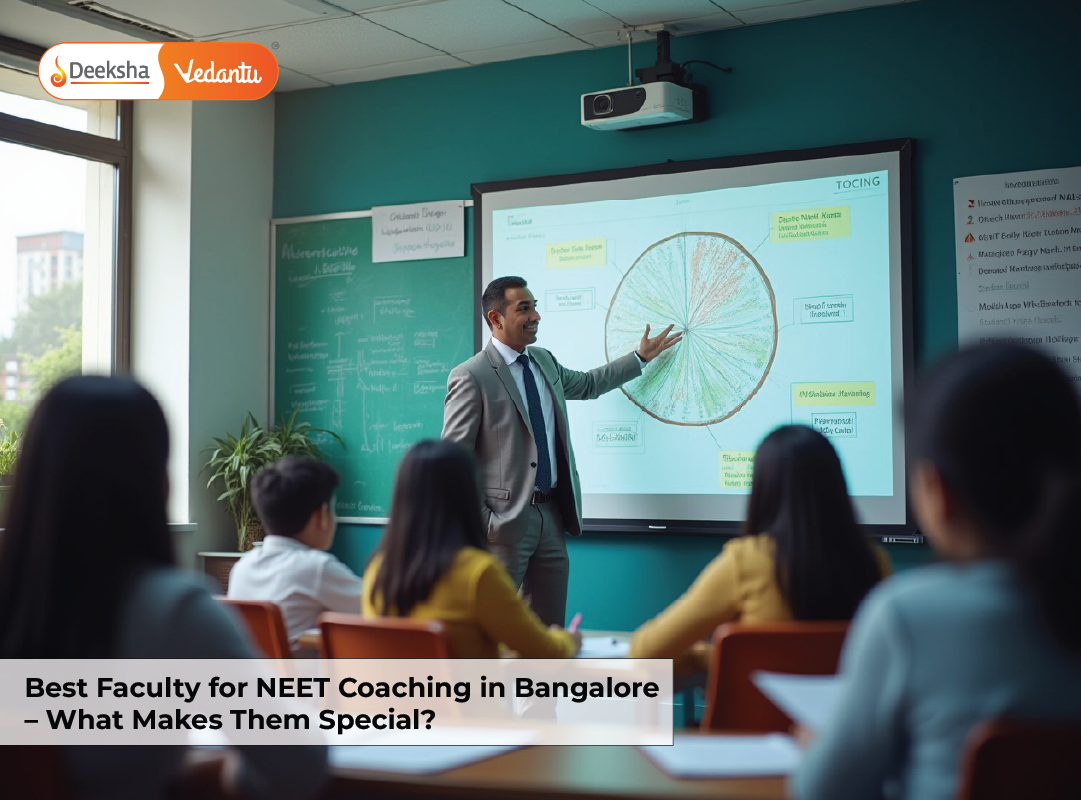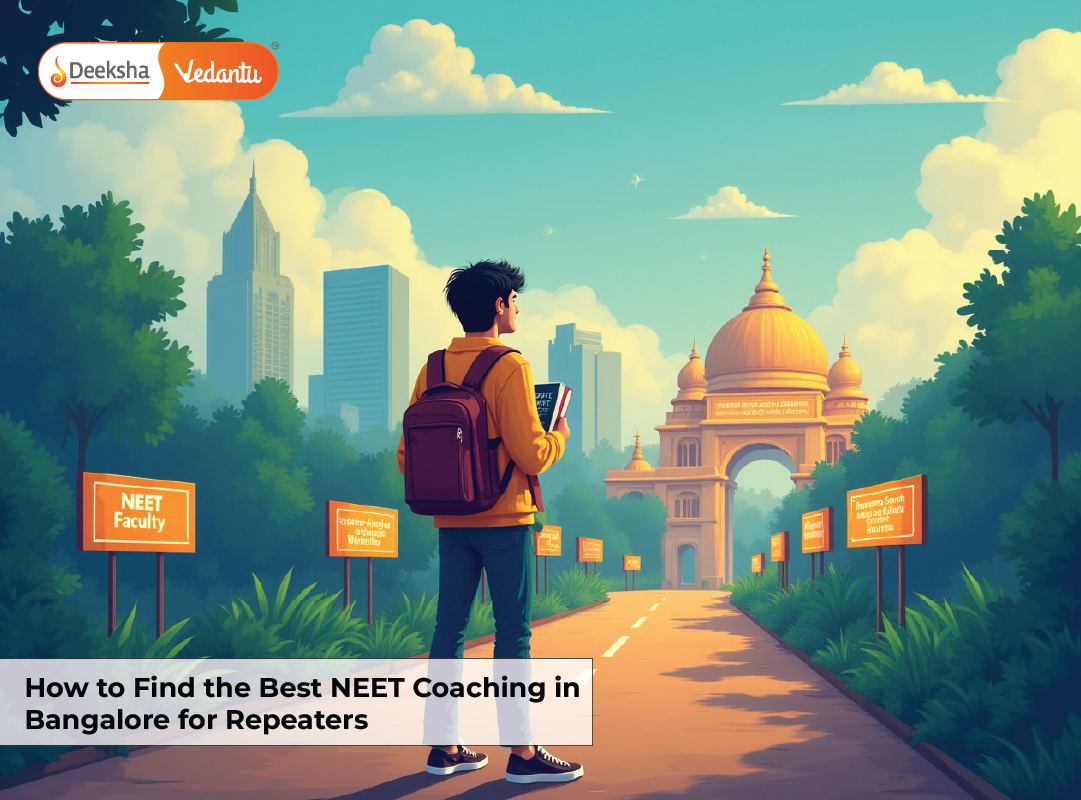Optics is one of the most scoring units in NEET Physics, with a mix of theory, direct formula applications, and easy-to-visualize concepts.
It covers:
- Ray Optics – Mirrors, lenses, refraction, optical instruments
- Wave Optics – Interference, diffraction, and polarization
Together, they contribute around 3–4 questions in NEET every year.
Why is it a student favorite?
- Most questions are diagram-based or formula-driven
- The concepts are intuitive and require visual clarity, not heavy calculations
- Many are direct NCERT lines or standard problem types
In this blog, you’ll learn:
- All essential concepts in Ray and Wave Optics
- Must-memorize formulas
- Solved examples from a NEET point of view
- Tricks to avoid mistakes in signs and diagrams
Explore Deeksha Vedantu Long Term NEET Coaching to boost your NEET Scores today.
NEET Optics Weightage & Chapter Trend
| Year | Ray Optics | Wave Optics | Total |
| 2020 | 2 | 1 | 3 |
| 2021 | 2 | 2 | 4 |
| 2022 | 2 | 1 | 3 |
| 2023 | 2 | 2 | 4 |
| 2024 | 2 | 1 | 3 |
- Ray Optics contributes consistently: image formation, lens combinations, mirror/lens formula
- Wave Optics often includes 1 question on YDSE, diffraction, or polarization
- Diagrams and sign conventions play a big role in accuracy
Mock tests boost speed and accuracy.
Ray Optics: Core Concepts
Reflection & Mirrors
- Laws of Reflection:
- Angle of incidence = angle of reflection
- Incident ray, reflected ray, and normal lie in the same plane
- Mirror Formula:
Where:
= focal length
= image distance
= object distance
- Sign Convention:
- All distances measured from the pole
- Against incident ray → Negative
- For concave mirror: f<0f < 0f<0
- For convex mirror: f>0f > 0f>0
Refraction & Lenses
- Snell’s Law:
Where n1,n2n_1, n_2n1,n2 are refractive indices, and i,ri, ri,r are angles of incidence and refraction - Lens Formula:
Sign conventions similar to mirrors:- Convex lens: f>0f > 0f>0
- Concave lens: f<0f < 0f<0
- Power of a Lens:
Unit: Dioptre (D)
Total Internal Reflection (TIR)
- Occurs when:
- Light travels from denser → rarer medium
- Angle of incidence exceeds the critical angle
- Critical Angle Formula:
(Where n1>n2n_1 > n_2n1>n2) - Common in NEET for fiber optics and prism-based numericals
Optical Instruments
- Magnification (m):
- Combination of Lenses (in contact):
Used in compound microscopes and telescopes questions.
Wave Optics: Key Concepts Made Simple
Interference of Light
- Constructive Interference:
Waves add up → bright fringe - Destructive Interference:
Waves cancel → dark fringe - Young’s Double Slit Experiment (YDSE):
Fringe width:
Where:= wavelength
= screen distance
= slit separation
Diffraction & Polarization
- Diffraction:
Bending of light near the edges of a slit or obstacle- Minima condition (Single Slit):
where = slit width
= wavelength
- Minima condition (Single Slit):
- Polarization:
- Light waves are transverse
- Polarized light vibrates in only one direction
- Not seen in sound waves (longitudinal)
Must-Know Optics Formulas for NEET
| Concept | Formula |
| Mirror Formula | |
| Lens Formula | |
| Power of Lens | |
| Snell’s Law | |
| Critical Angle (TIR) | |
| Fringe Width (YDSE) | |
| Lens Combination | |
| Diffraction Minima |
NEET-Style Solved Examples (with Explanation)
Q1. A convex lens forms an image 20 cm behind it of an object placed 30 cm in front. Find the focal length.
Solution:
Given:
(behind the lens = positive)
(object in front = negative)
Use the lens formula:
Take LCM of 20 and 30:
Answer: 12 cm
Q2. In a Young’s Double Slit Experiment, the slit separation is 0.2 mm, screen distance is 1 m, and wavelength is 600 nm. Find fringe width.
Solution:
Given:
Use the fringe width formula:
Answer: 3 mm
Q3. The critical angle for a medium with respect to air is 30°. What is the refractive index of the medium?
Solution:
We use:
Where (air),
So,
Answer: 2
Preparation Tips for Mastering Optics
- Always draw ray diagrams: It improves understanding and helps avoid sign errors in mirror/lens questions.
- Memorize sign conventions: Use the Cartesian sign convention. For example:
- Object left of mirror/lens → u=−u = -u=−
- Real image → v=+v = +v=+, Virtual image → v=−v = -v=−
- Convex lens/mirror → f=+f = +f=+, Concave → f=−f = -f=−
- Use ray tracing for image formation and lens combination setups.
- Practice high-frequency topics:
- Lens and mirror equations
- TIR (Total Internal Reflection)
- Young’s Double Slit Experiment
- Lens combinations and magnification
Set a target: Solve at least 50 MCQs (combined from Ray + Wave Optics) during revision.
FAQs on Optics in NEET
Q: Is Optics difficult in NEET?
A: No, Optics is one of the most student-friendly topics. It’s logic + formula + visualization. Most questions are straightforward if concepts and signs are clear.
Q: How many questions come from Ray and Wave Optics?
A: NEET typically asks 3 to 4 questions from Optics:
- 2 from Ray Optics
- 1–2 from Wave Optics
These include numericals and concept/theory-based MCQs.
Q: Which book is best for NEET Optics preparation?
A:
- NCERT Class 12 Physics (Part 2) – for complete theory and formulas
- MTG NEET Previous Year Questions – to spot recurring trends
- DC Pandey Objective Physics – Optics Section – for extra practice
Check out our NEET Residential Coaching option for focused preparation.
Conclusion
Optics is a high-yield, low-stress chapter in NEET Physics. You don’t need to memorize derivations or go deep into theory.
Instead, focus on:
- Visual clarity using diagrams
- Formula familiarity and when to use what
- Practice with sign conventions and proper units
With consistency, full marks from this unit are absolutely possible.
Table of Contents















Get Social